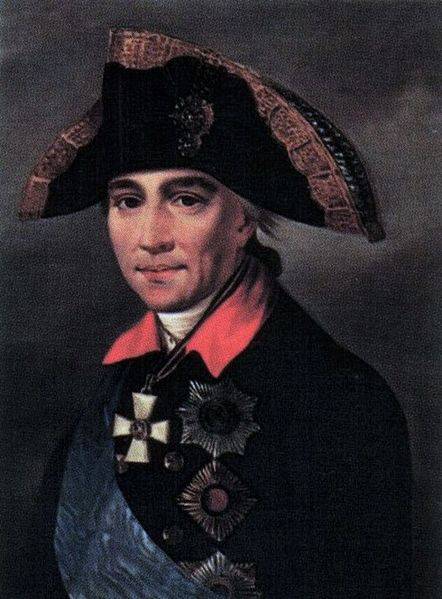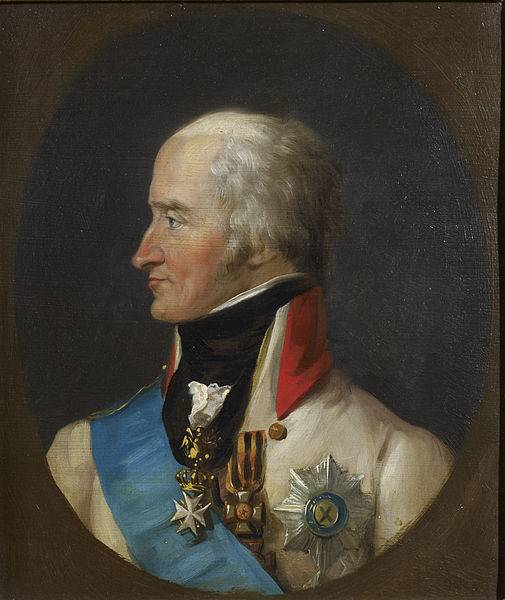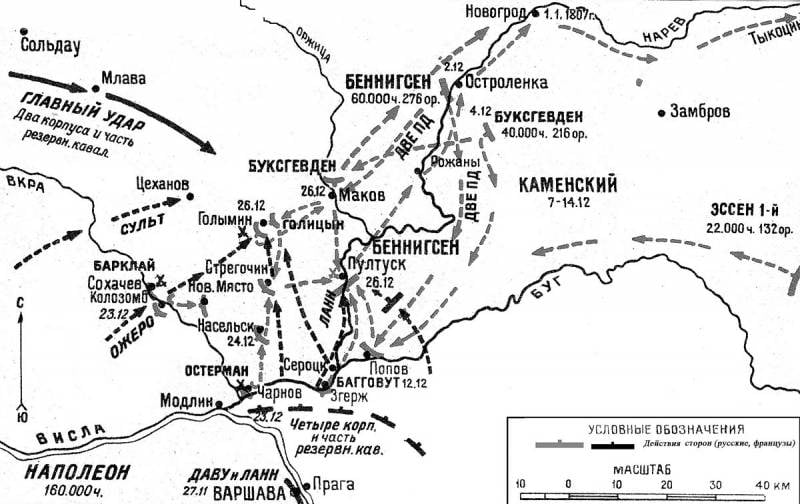The victory of the Russian army in Pultusk
11 (23) December 1806, when the French troops occupied the crossings on Wkre and Narew, the Russian army, which, according to Field Marshal Kamensky, was supposed to attack the corps of Soult and Ogereau, also moved towards the enemy. The corps of Bennigsen moved from Pultusk to Sokhochin, two divisions of the corps of Buxgevden went from Ostrolenka to the banks of the r. Vkra, the rest of the corps division - to Popov. Upon learning of the battles that had sustained the avant-gardes of Barclay de Tolly and Osterman, Kamensky ordered Bennigsen and Buxgevden to stop the movement and return.
12 (24) December Napoleon ordered the Lanna Corps to be reinforced by an infantry division from the Davout corps and the dragoon division from the reserve to take Pultusk. Soult and Augereau from Sokhina, Davout, the guards and reserve cavalry from Nasielsk were to go to the Golymin, Makov and Rojan. The troops of Bernadot, Ney were to continue to move to Strasbourg, throw away the Prussians to the north and enter Mlava, to the rear of the Russian army. Thus, on December 12 (24), Russian and Prussian troops were on the march. But moving extremely slowly, interfered with bad weather, strong wind, snow and rain, which turned the roads into a swamp.
At night, the vanguard of the Lanna Corps came out to Pultusk, the French wanted to intercept the crossing. However, Osterman managed to warn the Baggovut detachment and the Russian troops came first. After a fierce fight, the French were rejected. Realizing that the French want to surround the body of Bennigsen, Kamensky ordered to immediately go from Stregochin to Pultusk. As soon as the corps left Stregochin, the corps of Davou, moving from Naselsk, occupied it, cutting off the Russian rearguard, which had not yet reached Stregochin, from the main forces and Pultusk. These war were forced to retreat to the Golymin. During this retreat to Pultusk and Golymin, our troops lost a lot of wagons and more 50 guns. The commanders of the cut off regiments acted independently, walked separately, wandering along different roads, meeting the enemy on the way, which led the French into delusion. Napoleon decided that this was part of some plan of the Russian command, difficult maneuvers of the enemy. While the French emperor was trying to figure out the “cunning plan” of the Russians, he stayed with the guard and reserve cavalry in Nasielsk for several hours, and did not have time for the battle in Golymin.
13 (25) December, when most of the troops Bennigsen approached Pultusk, Kamensky ordered to prepare the troops for the battle. The commander-in-chief ordered the Buksgevden and Essen corps to concentrate in the Pultusk area. In the evening, Field Marshal examined the position. The troops happily greeted Kamensky. It must be said, soldiers and officers respected Kamensky, considering him to be the representative of the era of A. Suvorov and Catherine the Great, when the Russian army was invincible.
At the same time, Lann's corps approached Pułtusk, and the rest of the French troops were on the march to Golymin. As mentioned earlier, Napoleon decided to encircle and destroy the Russian army in the Golymin region, where, according to the erroneous data of the French intelligence, it was located. Proceeding from this plan, the main forces of the French army marched on Golymin.
The heavy worries and responsibilities of the commander-in-chief finally knocked down the health of the old Russian field marshal. Kamensky, apparently, at that time experienced a disorder of consciousness. On the night of December 14 (26), Kamensky suddenly refused the decision and ordered the troops to retreat to Russia. He himself, having removed his command, left for the rear. The relative of the commander-in-chief, Count Osterman, tried to convince him, correctly noting that Kamensky’s unexpected departure would undermine the army’s morale, but without success. Kamensky’s order to retreat did not reach all parts, introduced incredible confusion and almost led the Russian army to a catastrophe.

Field Marshal Mikhail Fedotovich Kamensky (1738 - 1809)
So, count Buksgevden fulfilling Kamensky’s order from December 13, in the morning December December 14 went from Makow to Pultusk. Under him, there was one division of Tuchkov, the division of Dokhturov was in Golymin (they ordered her to go to Pultusk via Makov). After walking a few miles across the terrible mud, he met Kamensky's courier, the field marshal ordered the general to lead the army, except for Essen’s corps, and withdraw troops to the borders of Russia. Buksgevden decided to return to Makov, and on the march he heard an artillery rumble from Pultusk and Golymina. Buksgevden did not dare to make a speech from Makov, wanting to find out what was happening with Bennigsen in Pultusk, at Dokhturov in Golymin, and what two divisions of his corps (Anrep and Essen) were doing, which were on the left bank of Narev. Thus, Buksgevden became the senior commander in the army, but did not know what was happening at that time, did not lead the army, having only one division with him.
When Buksgevden returned to Makov, the duty general, Count Tolstoy, arrived from Pultusk. He reported on the departure of the field marshal and called on Buksgevenden to go to Pultusk to help Bennigsen. Buksgevden said that although Pultusk is only 15 versts, but the roads are in terrible condition, and it will reach only in the evening when the battle is over. In addition, he does not know what is happening in the Golymina, from where the firing is heard. Buksgevden stayed in Macs. As a result, the general did not assist Bennigsen in the Battle of Pultusk.
Making excuses, Buksgevden wrote to Tsar Alexander: “I was in a hurry to Pułtusk, but the field marshal steered me from half the road. I could not know what the reasons were for this prescription, and even if I knew how it was revealed to me that the reasons are insignificant, I could not obey him, strictly knowing how to obey my boss, which is my first duty in military service, although in reality I shouldn’t have told me to return to Macs, because at the beginning of the battle I would have ripened to hit the left flank of the enemy, and, of course, would have overturned him decisively. ”
Battle of Pultusk
After conducting Field Marshal Kamensky, Bennigsen remained in Pułtusk, although he had orders to retreat to Russia. He decided to remain in an occupied position in order to allow the lagging behind regiments to unite with the main forces. Then it was possible, if necessary, to retreat to Russia. Bennigsen also hoped that the divisions of Anrep and Essen from the corps of Buxgevden would have time to approach him. Bennigsen did not know that Kamensky had canceled the movement of these divisions to Pułtusk and ordered them to go to Ostrolenka. Thus, Bennigsen assumed a great responsibility, not accepting the battle against the will of Kamensky and not recognizing the opinion of Buxgevden, who was now formally the commander.
The corps of L. L. Bennigsen numbered about 40 thousand people with 200 guns. Its main forces (13 infantry regiments) were located north-west of the city and occupied the 2,5 km on the front, with battle formation in two lines with the allocation of a reserve (1 regiment and 2 battalion). The right flank of the corps was provided by a separate detachment of Major General M. B. Barclay de Tolly (near the 4 regiments and 5 cavalry squadrons) advanced to the village of Moshino; left flank - a separate detachment of Major General KF Baggovut (3 Infantry Regiment, 1 Battalion, 1 Cavalry Regiment and 2 Squadron), located in 1 km south-west of Pultusk. From the front, the main forces covered the cavalry (the cavalry brigade of major generals I. S. Dorokhov and V. A. Kozhin), in front of which were the Cossacks. The total front of the Russian troops was about 5 km. Lieutenant-General F.V. Osten-Sacken commanded the right flank; Lieutenant-General A.I. Osterman-Tolstoy commanded the left flank.

Leonty Leontyevich Bennigsen (Levin Augustus Gottlieb Theophil von Bennigsen)
At 10, Marshal Lunn approached Pułtusk. The Lanna Corps (2 infantry divisions of Succeh and Gazan, the light-weight Montbren division and Becker’s dragoon division), together with the infantry division from Marshall Davout’s corps soon approached 30 thousand people with 120 guns (at the beginning of the battle, the French fighters would draw the bells. . Lunn decided to attack Bennigsen, counting on the help of Napoleon. The French commander decided to start a battle, not suspecting that his opponent had a twofold numerical advantage. He saw on the plain in front of Pultusk only cavalry and troops of the right and left wing of the Russian corps advanced. The main forces of Bennigsen at that time were hidden from the views of the French behind the hill located in front of Pultusk. Only much later, already getting involved in the battle, Lann learned that the Russians have a large numerical advantage.
Lannes built his troops in the 2 line: in the first - the infantry division Suchet (without the 40-th infantry regiment), in the second - the infantry division of Gazan and the 40-th regiment. Supe Claus was on the right flank (1 light infantry and 1 cavalry regiments) - he had to confront Baggovutu; in the center is Wedelle with the 64 infantry and 1 battalions of the 88 regiment. On the left flank were the remaining battalions of the 88 and the 34 th infantry regiment. They were supported by the dragon of the cavalry division of Becker. Later came the division of Gudin from the corps of Marshal Davout. The French left wing was closed from the Russians by the forest, and therefore the detachment Barclay de Tolly opposing him could not identify the real forces of the enemy. French artillery was placed in the center and left flank.
Having completed the construction, the French went on the offensive. Bennigsen ordered the cavalry to withdraw for the infantry lines. Coming closer, the French opened artillery fire and attacked Baggovut and Barclay. The French fought fiercely and pushed the Baggovut detachment. Bennigsen promptly dispatched Count Osterman with the 4 battalions and Major General Kozhin with His Majesty's Life-Kirasir regiment and the 2 squadrons of the Major Steel Starguard regiment to help the defending forces. Behind them, Osterman moved the hussar of the Izyum regiment, Pavlovsky grenadier and Murom musketry regiments.
Baggovut led his soldiers into a bayonet attack. She was supported by the cuirassiers of Kozhin and the dragoons of Steel, who struck the enemy’s flank. 3-4-th. the french column was crumpled, the enemy only captured lost about 300 people. As a result, the enemy was thrown back, the attack on the left wing of the Russian army was successfully repulsed.
The French attempted a second attempt to overturn the Baggovut detachment by the forces of the dragoon division. The French attacked the Izyum hussars, not seeing that behind them was an artillery battery. The hussars quietly waited until the mass of the French cavalry came close enough, after which they turned sharply to the left. The shots of grapeshot caused heavy damage to the enemy. The Count Osterman, who arrived with infantry, finally defeated the enemy and returned the position that Baggovut occupied at the beginning of the battle.
At the same time, a fierce battle was in full swing at Barclay’s plot. "With the courage and fearlessness of this general," noted Bennigsen, "he was forced to yield to a cruel and swift attack." The French even captured one of our batteries. However, our troops immediately counterattacked Tenginsky, 1-th and 3-th Jaeger regiments and beat off the guns. In order to restore the situation completely, Saken personally led Barclay de Tolly of Chernigos and Lithuanian Musketeer Regiments to help. After a stubborn battle, the French were rejected.
These failures forced the French to stop the attacks. Marshal Lannes waited for the arrival of Gudden's division, continuing the artillery fire. In 14 hours, the Güden Division arrived on the battlefield, and the French decided to try again to drop the Russians from Pultusk. The main blow the enemy struck on the right wing of Bennigsen. Lunn himself attacked in the center. At the same time, the French launched an attack on their left wing with the aim of holding down Russian forces. Guden's soldiers broke into the village of Moshina, bypassing Saken on the right.
Bennigsen promptly reacted to the emergence of fresh forces of the enemy. On his orders, Barclay de Tolly and Baggovut turned the right flanks of their troops back and strengthened them with artillery. The French bravely went forward, but came under heavy artillery fire. At the same time, Barclay attacked Güden’s left wing. In this attack, the Chernigov Musketeer Regiment, Major General Prince Dolgorukov, was especially notable. The Ulan squadrons of the Konno-Polish regiment, Lieutenant Colonel Zhigulin completed the defeat of the crumpled French column. After that, Lannes, receiving a report from Suchet about the failure on the right flank, stopped the attacks.
Bennigsen decided to go on the counteroffensive. Count Osterman was supported from the reserve by the Tula regiment and two battalions of the Revelsky regiment. As soon as Osterman's troops went forward, he went on the attack and Bennigsen with the troops of the right wing, reinforcing them with cavalry (Dorokhov's brigade and part of Kozhin's brigade). The simultaneous offensive of the Russian flanks and the skillful action of artillery decided the outcome of the case in favor of Bennigsen's troops. The French fought back fiercely, a stubborn battle continued for several hours. At 19 hours, the French began to leave positions. Darkness and blizzard did not allow Russian troops to pursue the enemy and complete the defeat of the enemy.
Results
The losses of the Russians in the battle amounted to 3,5 thousand people, the French (according to their clearly underestimated data) - 2,2 thousand people, including 700 people captured. The fact that Marshal Lannes himself was lightly wounded tells about the bitterness of the battle, Generals Suchet, Clapered, Wedell and Bonar were injured.
Both sides reported their victory. All the French attacks were repulsed, but Bennigsen did not use his considerable numerical superiority until the approach of the Gudin division. You can also note the inaction of Bouksgevden, caused by conflicting instructions from Kamensky. However, strategically, it was a success. In the course of the battle, the Russians stopped the advance of the enemy, and Napoleon Bonaparte had to part with the plans of the encirclement and the subsequent defeat of the Russian army.
At night, Bennigsen received a report on the movement of large enemy forces, bypassing his corps from the north. In connection with this morning of December 15 (27), he gave the troops an order to withdraw, which gave the French a reason to announce their victory in the battle.
For this victory, the emperor Alexander granted Bennigsen the Order of St. George of the 2 degree and 5 thousand chervonets, also the general soon became the commander of the whole army. The orders of St. George 3 degree were marked by other heroes of this battle - Count Osterman, generals Baggovut, Barclay de Tolly, Kozhin and Colonel Davydovsky. The commander of the 1 th eger regiment, Davydovsky, who was wounded in the case of Sokhochin, received a mortal wound near Pultusk.


Information